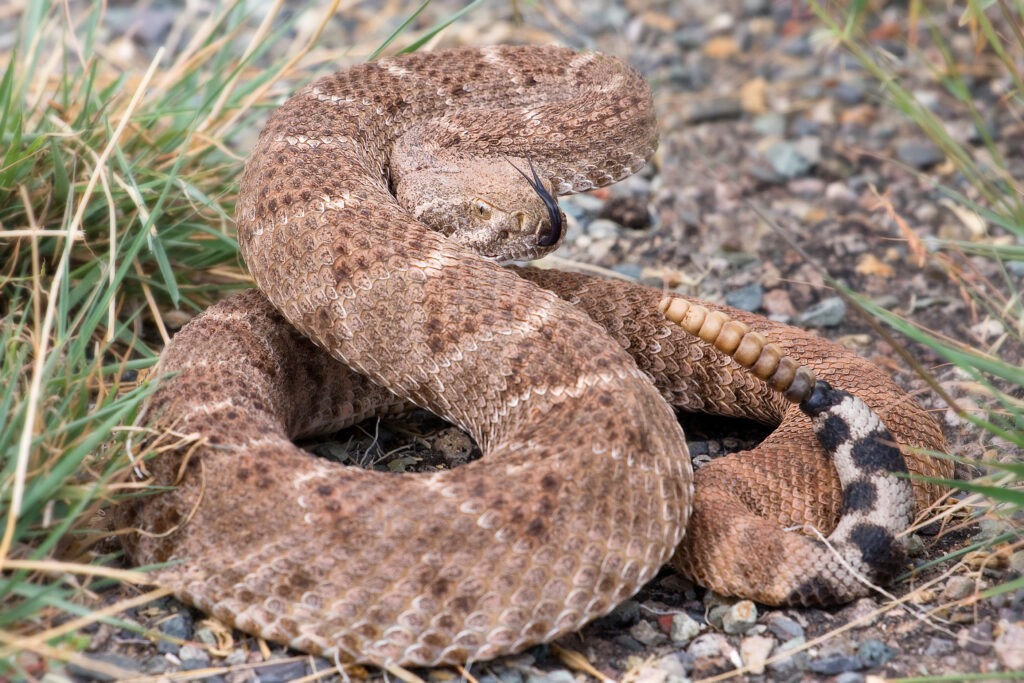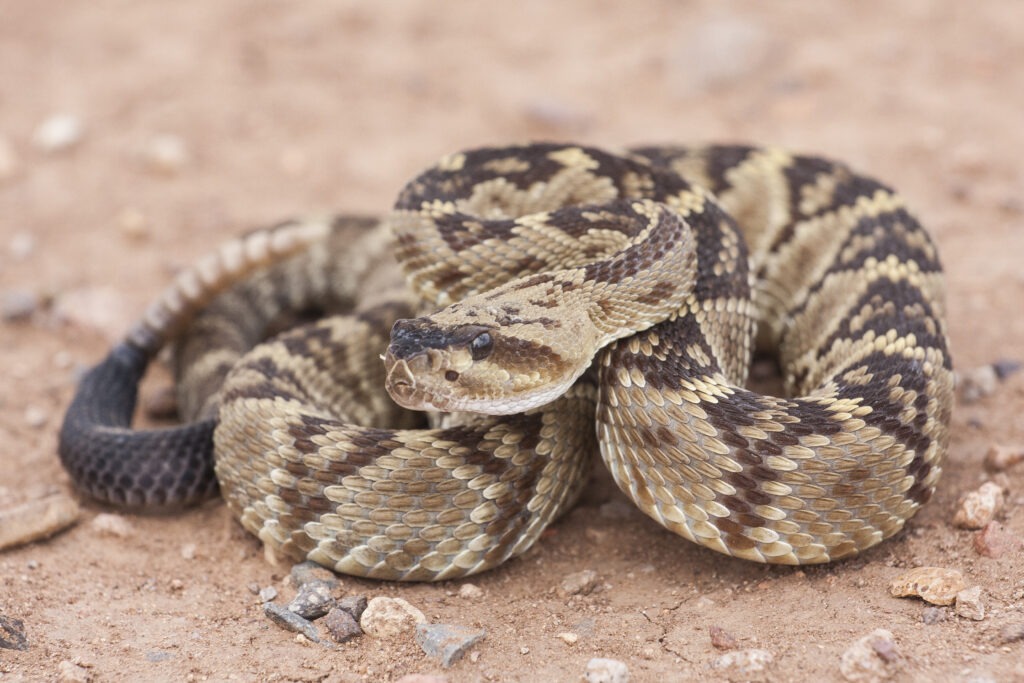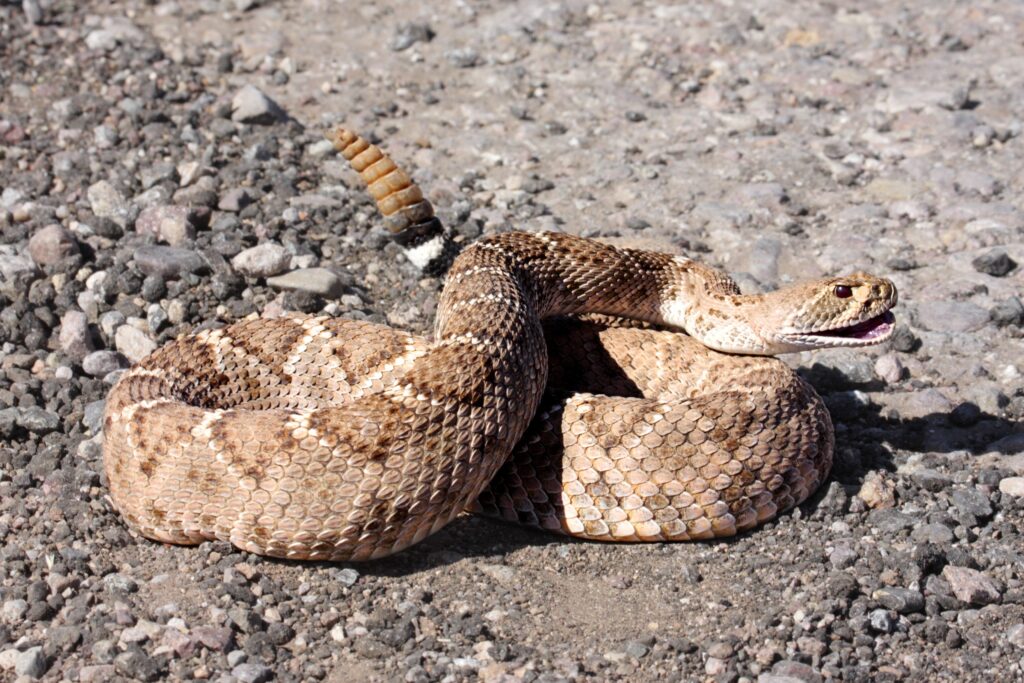
There’s nothing scarier than finding a rattlesnake in your yard. And that’s even more true if it’s a baby! After all, does that mean there are more or that mama is around? So what do you do if you find a baby rattlesnake in your yard?
Here’s what I’ve done:
As a general rule, if you find a baby rattlesnake in your yard, call a local animal control company, as killing or removing the snake is dangerous. But if calling isn’t an option, remove the head from the body using a long-handled shovel knowing that the head can still bite up to 90 minutes after decapitation.
When snakes feel threatened or aggravated, they will attack, which can be deadly. Leave it to professionals.
Rattlesnakes are more vicious than other snakes. So, it is a good idea to determine if the snake is small enough to easily capture and release. Otherwise, you should let professionals take it away for you.
Then, once the snake is gone, it’s a great idea to make sure there are no areas in your yard that are inviting snakes. Clear out (carefully) and remove woodpiles, debris, clean out storage sheds, and make sure to keep the grass trimmed regularly.
Do Not Lose the Rattlesnake
When you find a baby rattlesnake, don’t lose it.
Keep your distance, and try to keep your eye on the snake. If you take your eye off it, and it hides in a place where you can’t find it, then it will be hard to capture the rattlesnake.
Sometimes you have to leave the scene, so take a picture of the snake. That way you know what it looks like, and if you decide to have animal control take the snake for you, then they will know what type of snake they are looking for.

Should You Handle the Rattlesnake or Animal Control?
Before deciding to tackle the snake yourself or not, first determine how big it is.
If the baby rattlesnake is still small, then you might be able to handle it yourself. If the snake is long, or bigger than what you believe you can deal with without getting hurt, then call animal control to take care of it for you.
If you do not want to deal with the baby rattlesnake, or if you can’t for various reasons, then you should give your local animal control a call.
Capturing a rattlesnake should be a fast job for them to complete, so they can send someone over to take care of it for you.
If you want to handle the rattlesnake yourself but do not know where you should relocate it, you should still call animal control. They will either tell you where you should relocate the baby rattlesnake, or they might offer to come over and pick it up from you instead. Either way, the snake will be off your hands and you won’t have to worry about it anymore.
Capture and Release, or Kill?
After deciding if you can deal with the baby rattlesnake or not, there are two options as to what you can do with the snake.
You can either kill the baby rattlesnake or capture and release it. Remember, no matter what you decide to do with the snake, you will aggravate it and it may try to attack.
If you capture and release it, then you would be moving the baby rattlesnake far away from your home, and it should be far away from any home or business.
The rattlesnake should be relocated to an open field that is far away from places where people live or visit.
If you can capture it yourself, but do not know where to move it to, call animal control and ask them where they recommend moving it.
If you want to kill it, you need to cut off its head.
Shooting the rattlesnake is not recommended because you may not kill it, only injure it. A snake can still attack even if it has been cut in half.
The only way to kill the rattlesnake with certainty is to cut off its head because then it cannot keep striking.
But as I mentioned above, the head can still bite you for up to 90 minutes after being cut off. So it is extremely important to handle the head with great care. The snake can’t coil and strike, but if you pick up the head with your hand, it can easily bite you.
With the head of the snake cut off, the rest of the rattlesnake’s body will still move for a few minutes. It will not be slithering around moving to anyplace, it will just have some movement left in it.
Deciding to kill the rattlesnake or relocate it is entirely up to you.
Some people want to make sure the snake will not come back, and they opt to kill the snake. Other people feel bad for killing a rattlesnake and they prefer to capture and release it. One option isn’t necessarily better, it is just your personal preference. But I always relocate them myself.
When in doubt, always do the safe thing, which is to call a professional.

Will There be More Rattlesnakes?
If you found a baby rattlesnake, chances are that there could be more.
You can carefully scout your yard to see if you can find any more, or you can call animal control and ask them to do it for you. That way, if there is another one or multiple, animal control can take care of the problem right there for you.
If you find more rattlesnakes, you should get any rattlesnakes removed from your property and then begin rattlesnake-proofing your yard.
Rattlesnake-Proofing Your Yard
To rattlesnake proof your yard, you should look at the places in and around your yard where rattlesnakes can hide.
Snakes like shade, and they often hide under rocks to keep cool from the sun, so keep that in mind as you walk around your yard.
If you have already had one or multiple rattlesnakes in your yard, then you should begin rattlesnake-proofing the places where you found them first.
You can rattlesnake-proof an area by getting rid of hiding places for snakes.
After getting rid of hiding places, you can use store-bought repellant or poison around the perimeter of your yard. Be sure to read the instructions when dealing with poison.
If you have a garden, be careful with the poison because it could kill your plants.
You can also put wire fencing around the ground perimeter of your fences to further block them from slithering into your yard from underneath fences and gates.
You can also figure out why the rattlesnake liked your yard, and get rid of that reason.
For example, if there were mice for the snake, then get rid of mice. If there was good shelter, then get rid of the shelter. This way you can help prevent them from coming back.
Of course, I have to point out that I am not an animal control expert or a doctor and I do not provide professional or medical advice. I have years of experience in being around rattlesnakes, handling rattlesnakes, and removing them. But I have not been bitten, although I know people who have. You should not take my article as professional or medical advice and if you need professional or medical advice, and especially if you or someone you know has been bitten by a snake, you should immediately call 911 and seek out qualified medical assistance as quickly as possible.
